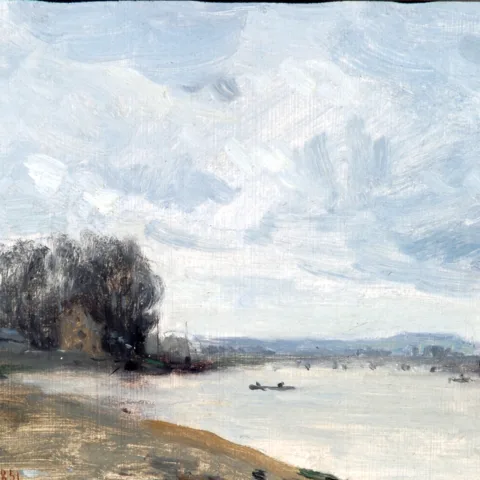The Bowes Museum Blog

The Passion Altarpiece – Laying the Problem to Rest
Once we had carried out a detailed examination of the painting (as described in a previous post), we could see quite clearly the main problems, and a treatment plan was devised. The main problem was the flaking of the paint layers.

Saint Jerome in raking light
We were surprised by the amount of flaking on the panels. During building work to refurbish the picture galleries in 2011, the altarpiece had been safely stored in another gallery, and the environmental conditions had been monitored. Only when re-installed in the picture gallery was the flaking was detected. It is also interesting that the outer paintings of the Founding Fathers (with the exception of St. Jerome) have suffered little in comparison with the paintings of the Passion, and the smaller, replacement panel, has no flaking at all. The detection of previous damage shows us that the panels have a history of flaking, the reason for this could be that the adhesion between paint layers and wood is poor. Environmental conditions have since been improved to attempt to discourage any further flaking.
The first action on our treatment plan was to stabilise the paint layers, and lay all the flaking paint. We ranked all of the areas of flaking on a scale of 3 (quite minimal) to 1** (very severe); most of the areas were scored a 3, with only a few ranked 1**.
To help us with the process of re-laying the paint flakes, we used a Preservation Pencil – a piece of specially-designed conservation equipment. The tool provides a fine jet of air, which can be heated to a desired temperature, and can be connected to a humidifier and directed onto the flaking paint. The Preservation Pencil has many uses in conservation, from cleaning and humidifying, to separating layers, and re-activating adhesives.
Directing a jet of warm (65 degrees Celsius), humidified air at for five seconds made the paint less brittle and more plastic. Once humidified, we used a fine sable brush to introduce Isinglass (a natural adhesive, more on which later), which penetrated through the cracks in the paint to the wood panel below. Where necessary on severely flaking areas, more humidified air was applied to further soften the paint.
Acid-free tissue was then placed onto the Isinglass to provide support to the paint.
Finally, a heated spatula (also 65 degrees Celsius) was applied to the surface, with hardly any pressure being used, – just the weight of the tool itself – to relax the paint and lay it flat onto the adhesive below.
The adhesive was left to cool and dry for a few minutes, before the acid-free tissue was removed with a moistened cotton-wool swab. Although it sounds nerve racking, as the paint layers are very delicate, it is a technique I have carried out before, and it is very successful.
Finally, a bit of information on Isinglass. It is traditionally made from the swim bladder of the sturgeon, which is now rare and expensive, so a cousin from the Indian Ocean now has the dubious honour of supplying the conservation community. The Isinglass is diluted in water in a 2% proportion, and remains stable and flexible for a long time. There are modern synthetic options which can be used as an alternative, but the Isinglass is time-tested and sympathetic with the materials from when the panel was originally made.
Jon Old, Conservation Manager/Paintings Conservator














